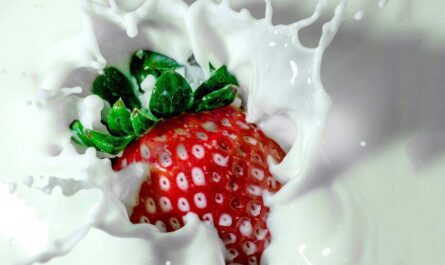What are some of the side effects and disadvantages of drinking (too much) milk everyday? Embarking upon the intricate journey of milk consumption necessitates a nuanced understanding of the myriad factors at play. It is within this complex tapestry that moderation and informed choices emerge as the linchpins of a wholesome approach to dietary habits. In the kaleidoscopic realm of nutritional decisions, the pivotal role of balance becomes evident, inviting individuals to tread carefully and consciously along the path of milk consumption.
Unveiling the Ramifications of Excessive Milk Intake
Delving into the intricacies of dairy consumption reveals a multifaceted spectrum of potential side effects and disadvantages associated with the unrestrained consumption of this ubiquitous beverage. The significance of prudence in quantity cannot be overstated, as an excessive intake of milk may unleash a cascade of adverse effects on one’s well-being. From digestive discomfort to potential nutritional imbalances, an awareness of these drawbacks underscores the imperative for a measured and judicious approach to milk consumption.
Individual Health Considerations: A Personalized Approach
In the labyrinth of dietary choices, the beacon of individual health considerations illuminates the path to optimal well-being. Each person’s unique physiological makeup demands a personalized approach to milk consumption. Factors such as lactose intolerance, allergies, and overall health status play a pivotal role in shaping the appropriateness of incorporating milk into one’s diet. A conscientious awareness of these personal intricacies ensures that the benefits of milk are harnessed without compromising individual health.
Ethical Perspectives: A Moral Compass in Dietary Choices
Beyond the realm of personal health lies the ethical dimension, a compass that directs individuals in navigating the sea of dietary choices. The dairy industry, with its implications for animal welfare, prompts a contemplative consideration of the ethical ramifications of milk consumption. Informed choices rooted in compassion and ethical awareness empower individuals to align their dietary habits with values that extend beyond personal health, fostering a harmonious relationship between humanity and the animal kingdom.
Disadvantages of Drinking (too much) Milk Everyday: 20 Side Effects
Amidst the intricacies of milk consumption, the echo of environmental consciousness reverberates as a call to action. The ecological footprint of dairy farming poses challenges to sustainability, prompting a reevaluation of our choices. Opting for eco-friendly alternatives and supporting sustainable practices within the dairy industry becomes paramount. By integrating environmental considerations into the fabric of milk consumption, individuals can contribute to the collective effort to preserve the delicate balance of our planet.
1. Lactose Intolerance and Digestive Issues
Excessive milk consumption brings forth a prominent concern rooted in lactose intolerance, an affliction where the body lacks the requisite enzyme to efficiently metabolize lactose – the inherent sugar found in milk. This enzymatic deficiency plunges individuals into a disconcerting realm marked by bloating, gas, and stomach cramps, all manifesting as unwelcome aftermaths post-indulgence in dairy delights. This predicament necessitates a judicious approach, prompting individuals to tactfully moderate their milk intake to sidestep the discomfort associated with lactose intolerance.
2. Risk of Hormonal Imbalance
Within the ostensibly wholesome elixir that is milk lies a nuanced peril – the presence of naturally occurring hormones like estrogen and progesterone, integral to the growth and maturation of tender calves. Yet, the dichotomy emerges when excessive indulgence in milk unravels the potential for perturbation in the intricate dance of hormones within the human body. This precarious deviation from equilibrium holds the potential to cast shadows on the regularity of menstrual cycles for women and instigate hormonal imbalances that reverberate across genders. A symphony intended for the bovine youth becomes a discordant note in the delicate hormonal composition of human physiology, warranting circumspect consideration in milk consumption practices.
3. Increased Mucus Production
Within the realm of physiological response, a whisper of anecdotal evidence hovers, suggesting a potential link between the copious consumption of milk and the orchestration of heightened mucus production. The anecdotal tapestry, though woven with individual perceptions, lacks the robust foundation of comprehensive scientific endorsement. Despite this limitation, individuals attuned to the subtle nuances of their bodily reactions find themselves at a crossroads. In navigating this labyrinth of perceived associations, a pragmatic approach beckons—meticulous monitoring of milk intake and a venture into alternative hydration sources. This proactive stance emerges as a rational response to address the specter of increased mucus production, even in the absence of resounding scientific concurrence.
4. Antibiotic Residue Concerns
Within the intricate tapestry of conventional dairy farming, the overture of antibiotic use emerges as a poignant note, struck to prevent and combat infections in bovine counterparts. However, the reverberations extend beyond the barns, stirring concerns about the potential vestiges of antibiotic residues finding refuge in the milk supply. This inadvertent infusion raises the specter of antibiotic resistance within the human populace. A strategic response to this looming threat involves a discerning choice – the preference for milk emanating from reputable sources, fortified with the armor of stringent quality control measures. This deliberate curation emerges as a shield, mitigating the apprehensions surrounding antibiotic residues and positioning the consumer as an advocate in the global battle against antibiotic resistance.
5. Fortification Discrepancies
In the nutritional lexicon, milk often dons the mantle of a fortified elixir, embellished with essential nutrients such as vitamin D and vitamin B12. However, the idyllic narrative of fortification encounters the nuances of reality, wherein variations in fortification levels permeate across different products. The resultant mosaic of nutritional benefits becomes a patchwork quilt, each square bearing the imprint of varied fortification practices. For consumers who anchor their nutritional sails to milk’s fortified shores, a clarion call echoes for mindfulness. The acknowledgment of potential disparities in fortification becomes the lodestar, guiding individuals toward alternative sources, ensuring an unwavering commitment to a comprehensive nutritional intake unscathed by the specter of fortification discrepancies.
6. Ethical and Animal Welfare Considerations
Beneath the veneer of nutritional discourse lies an oft-neglected facet – the ethical dimensions interwoven within the narrative of milk consumption. The agricultural tableau, where dairy farming unfolds its intricate dance, reveals a backdrop rife with ethical quandaries. The poignant separation of calves from their maternal embrace and the confinements that define their existence beckon introspection on the frontiers of animal welfare. Amidst this ethical crossroads, individuals with a moral compass finely attuned to the well-being of sentient beings find themselves contemplating alternatives. The ascendancy of plant-based milk alternatives or the embrace of products sourced from bastions committed to humane and sustainable practices becomes a beacon for those navigating the intricate intersection of ethics, animal welfare, and dietary choices.
7. Increased Risk of Acne
Beneath the seemingly innocuous veneer of milk, a burgeoning concern emerges from the shadows – a potential liaison between milk consumption and the exasperation of acne. The intricate interplay of hormones and growth factors intrinsic to milk reveals a clandestine influence on the skin’s oil glands, orchestrating an overture of increased sebum production. This orchestrated symphony, however, is not one of harmony; rather, it resonates with the discordant notes of acne development. What are the disadvantages of drinking milk? Those predisposed to the capricious nature of skin maladies find themselves at a crossroads, contemplating a measured reduction in milk intake to assuage the looming specter of dermatological tribulations.
8. Environmental Impact
Beneath the surface of a seemingly innocuous daily ritual – the consumption of milk – lies an environmental tapestry woven with consequences. The ramifications of mass milk production unfurl a tapestry painted with hues of ecological concern. The sprawling landscape of livestock farming, dedicated to the pursuit of milk, becomes an unwitting contributor to the symphony of environmental degradation. A crescendo of greenhouse gas emissions, deforestation, and the insidious notes of water pollution forms an orchestration demanding the attention of conscientious consumers. In this pressing ecological dilemma, the behemoth that is the dairy industry casts a colossal environmental footprint, urging individuals to recalibrate their milk consumption in the crucible of sustainability.
9. Dental Issues and Cavities
Within the juxtaposition of milk’s dental duality lies a narrative both paradoxical and cautionary. Despite the commendable calcium content that ostensibly allies itself with tooth health, an insidious underbelly reveals itself through the tandem companionship of lactose and natural sugars nestled within the milk. The precarious tightrope walk of excessive milk consumption, particularly in the absence of meticulous oral hygiene, unfurls a carpet conducive to the unwelcome growth of bacteria.
This microbial colonization, left unchecked, heralds the onset of dental tribulations, chief among them being the insidious cavities. The conundrum faced by dental enthusiasts thus beckons for a meticulous balance, whereby the virtues of calcium are harmonized with the potential pitfalls, necessitating judicious dental care practices concomitant with the tempered embrace of milk.
10. Altered Blood Sugar Levels
In the intricate choreography of physiological responses, the oft-overlooked lactose content in milk emerges as a subtle puppeteer, exerting influence over the delicate balance of blood sugar levels. This nuanced dance takes center stage, especially for individuals navigating the labyrinth of insulin resistance or grappling with the intricacies of diabetes. what are the disadvantages of drinking milk?
While milk graciously boasts a lower glycemic index compared to some other carbohydrate-rich counterparts, its impact on the glycemic symphony should not be relegated to the periphery. Vigilance becomes paramount as individuals, mindful of their unique health landscapes, engage in a delicate tango with blood sugar regulation. In this intricately woven narrative, the counsel of healthcare professionals becomes an indispensable compass, guiding those with concerns through the nuanced intricacies of milk consumption within the realm of blood sugar management.
11. Environmental Hormone Concerns
Beyond the ostensibly pure elixir of milk lies a concern nestled in the whispers of environmental hormones – an echo of agricultural practices reverberating through the dairy farming landscape. The specter of growth-promoting substances, woven into the fabric of modern dairy farming, introduces a subtle undercurrent of exogenous hormones into the milk supply.
This seemingly innocuous addition raises the curtain on concerns surrounding potential endocrine disruption within human physiology. In the face of this environmental conundrum, a clarion call echoes for adherence to regulatory guidelines and a discerning embrace of alternatives. Opting for the sanctity of organic or hormone-free milk options emerges as a strategic refuge, offering a tangible pathway to assuage concerns and navigate the nuanced intricacies of milk consumption within the context of environmental hormone exposure.
12. Impact on Iron Absorption
Delving into the intricate interplay between milk and the body’s nutritional tapestry, a chapter unfolds wherein calcium and casein, resident constituents of milk, cast a shadow over the absorption saga of iron from plant-based sources within the digestive realm. For those entwined in a symbiotic dietary relationship with milk, a subtle compromise manifests itself – the inadvertent undermining of iron levels, potentially paving the path to anemia over time.
To navigate this nutritional tightrope, individuals burdened with concerns about iron deficiency must assume the role of strategic tacticians. The careful management of milk intake, coupled with a diversified portfolio of dietary iron sources, becomes the compass steering them away from the precipice of anemia, ensuring a nuanced equilibrium in nutritional sustenance.

13. High Saturated Fat Content
Embarking on the exploration of the nutritional labyrinth within milk, a spotlight converges upon the saturated fat reservoirs concealed within the richness of whole milk. While the symbiotic relationship between saturated fats and a balanced diet is acknowledged, a caveat emerges – an excess of this dietary camaraderie heralds potential repercussions. The indulgence in whole milk, with its discernible saturated fat content, assumes the role of a double-edged sword, capable of elevating cholesterol levels and unfurling a red carpet to the looming specter of cardiovascular diseases. A prudent maneuver in this nutritional landscape involves a calculated divergence towards lower-fat milk alternatives, a strategic choice that seeks to uphold heart health without sacrificing the nutritional bouquet that milk proffers to the discerning consumer.
14. Bone Health Paradox
Within the realm of nutritional folklore, an axiom has been etched – the consumption of copious amounts of milk begets robust bone health. However, a paradoxical twist unravels as the reality diverges from this popular belief. The ostensible richness of milk in calcium, while indubitable, unfurls a conundrum when consumed in excess.
This abundance initiates a delicate dance, choreographed by the calcium-phosphorus ratio, with potential ramifications on calcium absorption. The paradox takes root, raising apprehensions about the veritable benefits of milk as an unwavering guardian of bone health. A clarion call echoes for a judicious and nuanced foray into dairy intake, transcending the simplistic narrative that abundant milk equates to unassailable skeletal fortitude.
15. Potential Allergic Reactions
In the kaleidoscope of potential drawbacks associated with milk, the canvas is tinged with the hues of allergy, albeit relatively uncommon. Concealed within the protein tapestry of milk, notably casein, and whey, lie allergenic triggers capable of unleashing a cascade of health concerns. The spectrum of reactions spans from the benign flutter of hives to the sinister specter of anaphylaxis, a life-threatening manifestation of allergic response.
Discerning individuals must navigate this allergenic minefield with circumspection, cultivating an acute awareness of potential reactions. For those already acquainted with the capricious nature of their immune systems, judicious prudence dictates moderation in milk consumption, the safeguard against an inadvertent encounter with an allergic tempest.
16. Caloric Overload and Weight Gain
What is the disadvantage of drinking milk? Contrary to popular perception, the innocuous appearance of milk belies its calorie-laden nature, particularly when imbibed in its unadulterated entirety. The seemingly benign beverage, when consumed in excess, becomes an unwitting accomplice in the insidious phenomenon of caloric overload.
This surplus of energy intake, especially prevalent in the unabridged richness of whole milk, disadvantages of drinking milk daily, lays the foundation for a weight gain trajectory, unfurling the ominous banner of heightened susceptibility to complications tethered to the realms of obesity. Navigating this dietary minefield mandates a discerning balancing act, urging individuals to calibrate their milk consumption to preserve a harmonious equilibrium in maintaining a weight deemed healthily proportionate. First Aid & pharmacy·Diet & Nutrition·Spa & Personal Grooming·Hygiene·Birth Control
17. Potential for Contaminants
Within the seemingly pristine embrace of milk lurks the potential for a surreptitious infiltration of contaminants – an invisible peril manifesting in the form of pesticides, heavy metals, and environmental pollutants. The insidious dance of these unseen foes poses a latent threat to the integrity of this dietary staple. Safeguarding against this hidden menace necessitates a vigilant gaze toward the quality of milk sources. The consumer, armed with discernment, is urged to champion products subjected to the crucible of rigorous testing and quality control measures. This proactive stance emerges as the armor shield against the inadvertent ingestion of harmful contaminants, ensuring the sanctity of the milk-filled chalice.
18. Interference with Medications
In the intricate ballet of dietary interactions, the seemingly innocuous calcium content within milk emerges as a potent orchestrator capable of disrupting the absorption dynamics of certain medications. The silent interference unfolds notably with antibiotics and specific antacids, casting a nuanced shadow over the symbiotic relationship between medication and nutrition. Individuals ensnared within this intricate dance, particularly those prescribed medications susceptible to calcium’s sway, are summoned to the corridors of healthcare expertise.
Here, the counsel of healthcare professionals becomes a compass guiding optimal timing and strategic maneuvers for medication administration, weaving a delicate tapestry that safeguards against interference while ensuring an adequate nutritional embrace. Eyeglasses, Sunglasses, and Contact Lenses, from Gucci, Kate Spade, and Michael Kors. Eye Doctor, Eye Exam, Insurance
19. Psychological Dependency and Dietary Imbalance
Within the narrative of dietary choices, an allegory emerges wherein the reliance on milk assumes the role of a cornerstone, a linchpin anchoring the broader edifice of nutritional sustenance. However, this seemingly innocuous reliance may unravel into the intricate tapestry of psychological dependency. The allure of milk, while undeniably rich in nutritional virtues, beckons individuals into a potential vortex where dietary diversity wanes and imbalance becomes an inadvertent consequence.
A clarion call resonates for those entwined within this dietary narrative – the imperative to transcend the myopic fixation on milk. The essence lies in cultivating a diversified and varied nutritional intake, a banquet that traverses a spectrum of food sources. In this symphony of nutritional abundance, individuals chart a course away from the perils of psychological dependency, ensuring a harmonious balance that meets the kaleidoscopic needs of the body. Vital Health and wellness solutions on Amazon for your healthy life
20. Cost and Economic Considerations
In the labyrinth of dietary choices, an economic quandary unfurls itself, tethered to the perceived elixir of milk. The sustenance derived from this dairy stalwart, while unquestionable, introduces a financial calculus into the narrative. For households grappling with limited economic resources, and the disadvantages of drinking milk daily, the consistent procurement of milk, especially of high-quality or specialty varieties, assumes the guise of a fiscal tightrope walk.
The tension between dietary aspirations and budgetary constraints prompts a strategic exploration of alternatives. The imperative to discover cost-effective and nutritionally sound substitutes becomes the lodestar, steering individuals toward a harmonious equilibrium where health is not compromised in the shadow of economic considerations.
Other Interesting Articles
- 20 Benefits of Drinking Tea Before Breakfast, Side Effects
- 21 Honeysuckle Flower Tea Health Benefits, and Side Effects
- 22 Benefits of Drinking Hot Tea After A Meal, Side Effects
- 22 Lemon Tea Health Benefits, Nutrition, Recipes, Side Effects
- 20 Benefits of Drinking Tea with Milk and Sugar, Side Effects
- 19 Olive Leaf Tea Health Benefits, Nutrition, Recipes, Effects
- 15 Mint Tea Health Benefits, Nutrition, Recipes, Side Effects
- 20 Common Disadvantages and Side Effects of Drinking Tea
- 17 Pumpkin Spice Tea Health Benefits, Nutrition, Side Effects
- 21 Health Benefits of Drinking Tea with Milk without Sugar
- 17 Bush Tea Health Benefits, Nutrition, Recipes, Side Effects
- 20 Benefits of Drinking Tea in the Afternoon with Weight
- 14 Mamaki Tea Health Benefits, Nutrition, Recipes, Side Effects
- 20 Amazing Health Benefits of Drinking Tea in the Afternoon
- 12 Yerba Mate Tea Health Benefits, Nutrition, Side Effects
- 22 Benefits of Drinking Tea in the Evening with Cinnamon
- 16 Turmeric Tea Health Benefits, Nutrition, Side Effects
- 23 Health Benefits of Drinking Tea in the Evening with Ginger
- 14 Chrysanthemum Tea Health Benefits, Nutrition, Side Effects
- 20 Health Benefits of Drinking Tea in the Evening with Lemon




